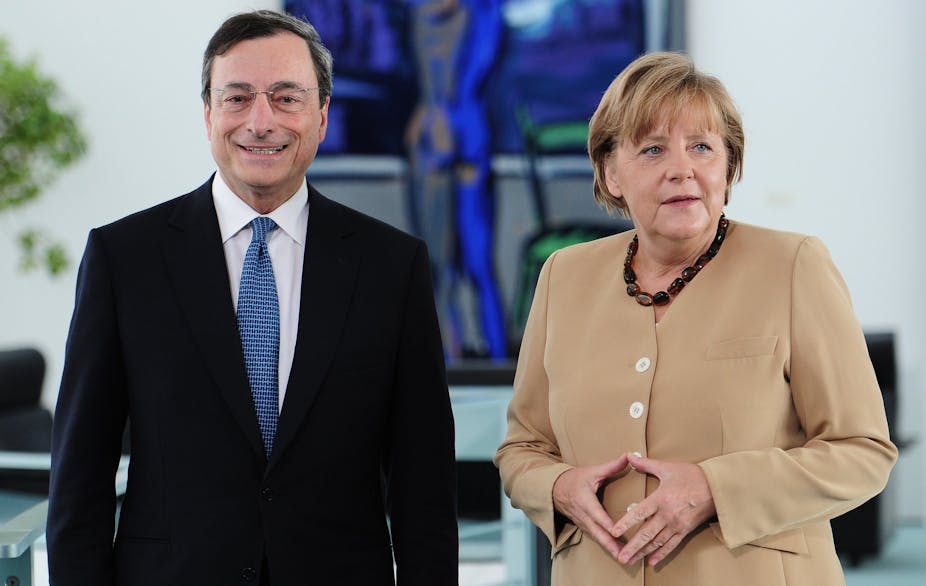We are in a new phase of the post-crisis world. Growth is disappointing with Italy in recession, France close to it, and even Germany lagging. It is a useful reminder that recovery in a debt-overhang economy with competitiveness and banking problems takes much longer than usual. Fortunately, Europe’s biggest economy has the potential to lift the spirits.
European Central Bank (ECB) president Mario Draghi made waves with comments that implied Eurozone countries should move away from austerity to encourage growth. German magazine Der Spiegel even reported that chancellor Angela Merkel called Draghi to complain about the tone of his comments. Merkel has been the key cheerleader for austerity as countries like Greece and Porugal struggled free of the financial crisis, but should Germany now loosen its purse strings? Is stimulus the saviour?
No. It will only postpone problems. And other solutions would have more impact. If excessive public debt was a key reason for the Eurozone crisis, then there’s no alternative to bringing levels down. Loosening fiscal policy to stimulate demand cannot solve structural problems. In open economies, demand leaks abroad by raising imports.
Jacking up EU structural funds could provide better targeted help to the least productive countries, but fiscal stimulus gives you artificial demand that just disappears again. People and firms know that deficits today will force them to pay even more tax in the future which nurtures pessimism and discourages investment.
Driving demand
The ECB has set interest rates at record lows for quite some time. Given extremely low inflation and stagnant growth, it even set a negative rate for central bank deposits. The ECB has implemented and announced further measures to inject liquidity. The idea, of course, is that low interest rates favour investment and make households shift demand from the future to the present by reducing savings. It might help drive down the Euro exchange rate which makes Eurozone exports more competitive but also creates import price inflation.
While appropriate today, continuing this kind of policy for too long creates new risks. It contributes to asset price inflation which triggers new shocks when interest rates finally rise and asset prices have to be corrected. Reaching savings targets in life-insurance and pension plans gets more difficult. Savings and wealth accumulation are effectively discouraged.
Investment and credit demand are the main problems. They remain stagnant even though interest rates have been low for so long. Despite a very low cost of capital, investment simply won’t pick up if expected future demand is low; if those with money to put to work expect competitiveness to decline; and if institutional barriers to investment are coupled with general uncertainty.
And so, a credible program for competitiveness and growth should do away with these barriers to make low interest rates effective. More growth creates future income and demand, a precondition for investment. Productivity gains and lower taxes create competitiveness. You can boost investment by reducing barriers to entrepreneurship; eliminating bureaucracy, corruption and wide-spread tax evasion; and doing away with excessive regulation. Businesses, including banks, should be allowed to fail.
Wages and tax
That’s a blueprint of sorts for the Eurozone as a whole, but what should Germany be doing if Draghi’s call is to go unheeded?
First, it should allow internal appreciation by tolerating higher wage agreements. The key point is to allow Germany as an export nation to enjoy the gains from trade that it would reap as an independent country with a separate Deutschmark. In addition, this will create more demand than a fiscal stimulus, and will lead to some cost push inflation which reduces the risk of Eurozone deflation, until the relative price adjustment between countries is complete.
Governments’ efforts to reduce their deficits are unavoidable but this must be done in a growth friendly way. In high tax countries with high tax resistance, this means cutting taxes rather than hiking spending. That is the second step for Germany: cutting spending in order to reduce taxes from overly high levels. Next, there should be a shift in the composition of public spending towards investment in research and development, technological infrastructure, education and other productivity enhancing measures.
It is a formula to create better expectations for the future which would help low interest rates and high liquidity translate into more private investment. It would support industry to better cope with higher wage costs and make wage concessions more acceptable. These two policies would reduce asymmetries in the Eurozone, spread out growth dividends more broadly, and make Germany an engine of growth in Europe.

